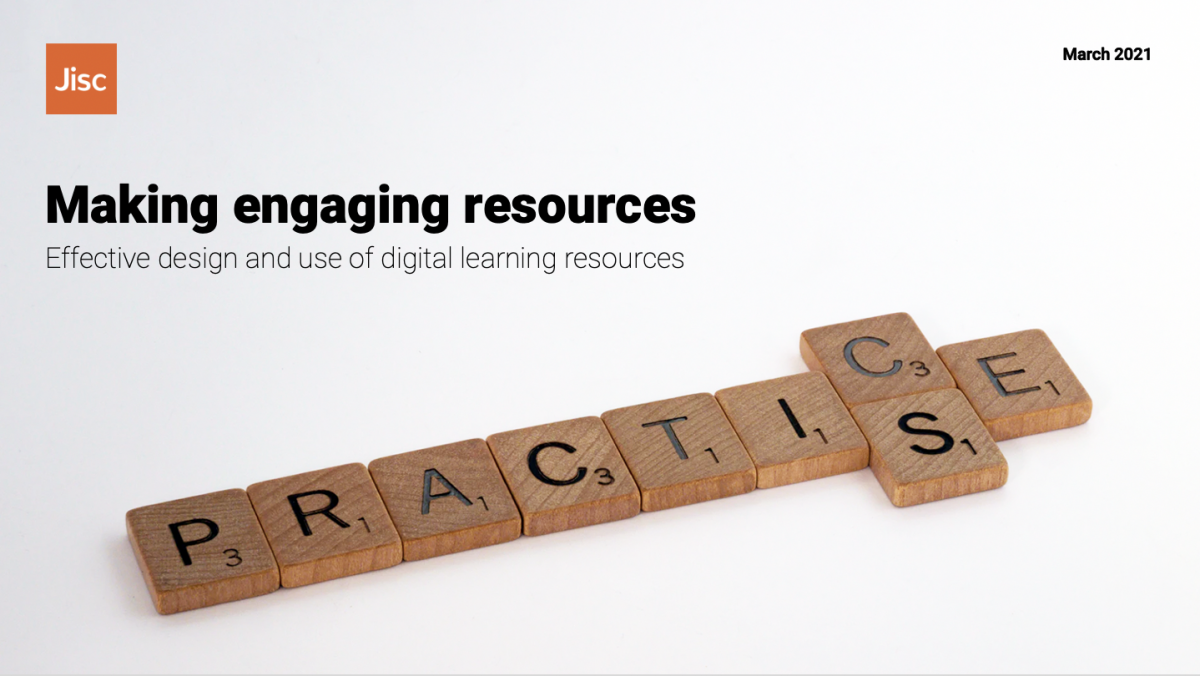Effective design and use of digital learning resources
Webinar 1 – Making effective digital learning resources
This session was recorded on the 23rd March in Zoom.
As part of a programme of sessions and blog posts on ‘Effective design and use of digital learning resources’ for the FE, WBL and ACL sectors in Wales, the first webinar was aimed at defining what a digital learning resource is, good practices and an introduction to using images safely.
Transcript for the session: https://docs.google.com/document/d/1LzSWIErbv0rZ2rzB4-kFLDVHd_9O9N42PDwF14OLrvc/edit?usp=sharing
Digital Learning Resources defined
The Jisc Digital Learning Resources in FE Teaching Toolkit tells us that digital learning resources are “multimedia materials that can be used to enhance learning and teaching”. It explains that they come in a variety of formats” such as interactive activities, simulations, animations, infographics, audio clips, videos, games and quizzes.”
That’s certainly a helpful starting point, but what makes a digital resource into a digital learning resource?
It seems that the answer to that question may not be so much about the digital content itself, important though that may be. It’s more to do with how the resource is intentionally used and supported in order to create a learning experience. In the words of The Open University in their free short course Take your teaching online, a teacher’s choice of software to create resources should focus on what can “bring their online teaching alive with a range of media”.
If we think of a digital learning resource in this open-minded way, the digital content no longer appears as the “be all and end all”. What really makes the difference is what you do with this resource and how it fits into your learning design to enable active learning to take place. Here, the distinction between a digital resource on the (web) page and the digital tool/s used to create and deliver the learning experience can get quite blurred. Perhaps that doesn’t matter, as long as the learning happens and the learner is well supported.
Keeping an open mind
Definitions of digital learning resources often emphasise multimedia but tend to exclude the many text-based resources (such as e-books) that a library or learning resource centre usually provides for learners. But keeping an open mind about sources and formats of digital learning resources can help ensure that we don’t miss opportunities to incorporate high quality, useful and readily-available materials within active learning pedagogy.
Best Practices
Whether you are just beginning in creating digital learning resources or are an experienced developer, we wanted to share some common best practices to ensure you are able to produce resources that are effective and safe to share with your learners.
It isn’t good practice to throw text, audio, video, images etct into a resource without proper planning or consideration to the key basics needed to take advantage of using digital in your teaching.
Why not though? There are plenty of sources for great content that may fit your learning outcomes for your digital learning resource. Not all of it will be accessible, inclusive, copyright free or compliant with rules that govern what we can or can’t use with our learners. GDPR, for example, has strict rules that we must abide by. We can’t bypass it. If creating digital learning resources in tools or platforms that are non compliant, we are open to problems and risk having to remove it completely.
Effective digital learning resources that are safe to share with learners will have good practices embedded in their design, planning and development. Understanding the hoops you need to jump through is important.
Pictures speak a thousand words. The right images say even more
One of the great ingredients to an effective learning resource is good images. Some are specific to the learning, others can be for style or cosmetic effect. Whatever the reason, the way you search or where you search for images, can have a big impact on the success of finding an image you can use. A google image search needs to be adjusted to include only images that have licenses that allow for your intended use. Even then, you need to check the license for each image.
But things have gotten a bit easier. We are now blessed with sites like Unsplash and Pixabay which are filled with attribution free, free to use images. With thousands of images being added daily, from highly skilled, independent photographers to companies like NASA and Microsoft, these websites are a wonderful tool.
Next session
How can we create engaging bilingual resources that can help to introduce and use the Welsh language with learners?
In this session the Coleg Cymraeg Cenedlaethol will look at how to create and use engaging Welsh medium and Bilingual resources to develop learners Welsh language skills. They will share tips to help you get started and highlight some pitfalls to avoid. There will be an introduction to the Coleg’s Porth Adnoddau which is the home of the Welsh-medium and bilingual resources. There will be lots of opportunity to share current practice, discuss common issues and find out what others are doing.
Date: April 27th 12.00-1.30pm
It is aimed primarily at practitioners in FE, ACL and WBL who are beginning to develop and use Welsh-medium and bilingual digital learning resources in their work or want tips on where to start. It may also be of interest to those who are leading staff in digital practice within those sectors.
Please note that numbers for this session are limited to 100 so you are encouraged to join the session in good time to avoid disappointment. However, it will be recorded for those who are unable to attend. If you want to attend the session or be notified when the recording is available, please email wales@jisc.ac.uk.

